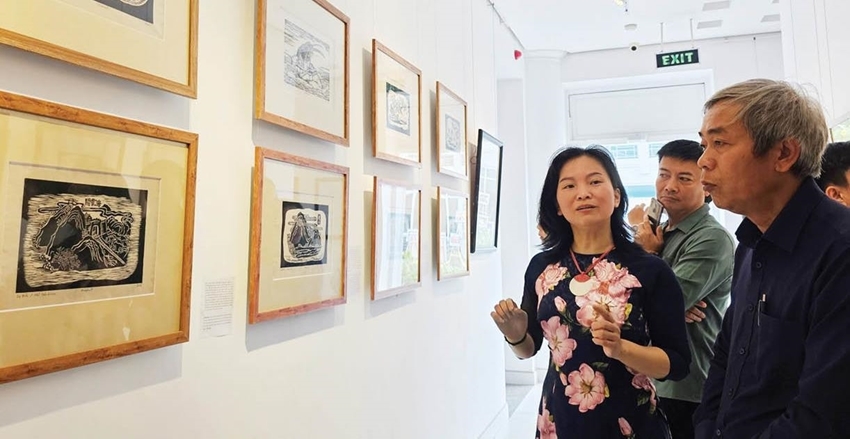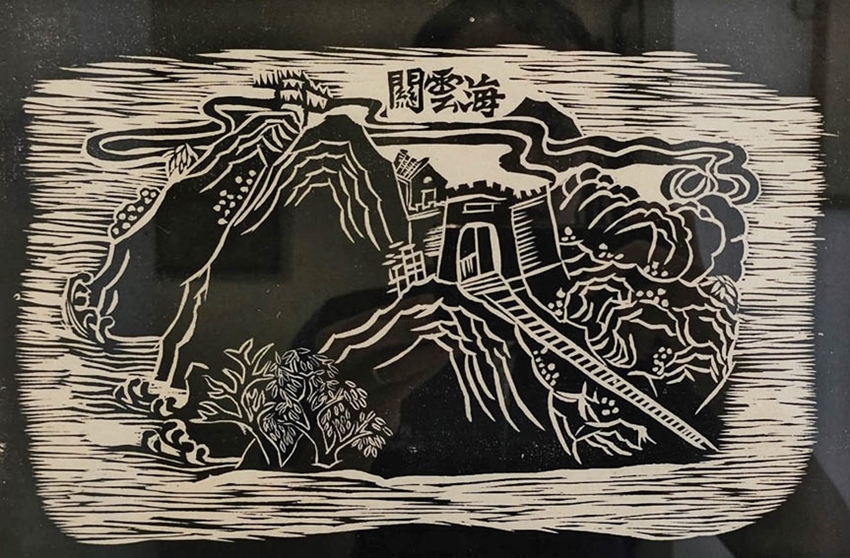 |
| Assoc. Prof. Dr. Trang Thanh Hien introduces wood engravings with inspiration from the Nine Urns |
Assoc. Prof. Dr. Trang Thanh Hien, a lecturer at the Vietnam University of Fine Arts, has been working diligently for the past two years to pursue her passion. She and her colleagues recently published their works in Hue, a place known for its treasure of the Nine Urns. The viewers were left surprised and impressed by their artwork.
To bring the Nine Urns closer to the public
During the final days of March, visitors to the Le Ba Dang Art Center, which is a part of the Hue Museum of Fine Arts, were taken aback by the display of over 60 wood carvings. The carvings were made using the images from the Nine Urns. These images include natural phenomena, mascots, territorial waters, rivers and mountains, animals, insects, herbs, architecture, palanquins, boats, weapons, and Chinese characters. The project team vividly, skillfully, and meticulously portrayed these images on wood carvings.
When researching and teaching about fine arts, Assoc. Prof. Dr. Trang Thanh Hien has studied quite carefully the art of the Nguyen Dynasty and recognized its significant historical value. The lecturer was most impressed by the national treasure of Nine Bronze Urns, which were minted by Emperor Minh Mang in 1835. These urns are considered a symbol of the dynasty's enduring strength. All of the bronze cast carvings on Nine Urns have been compiled into an "encyclopedia" about a thriving country under Minh Mang, which captivated a group of artists from Hanoi led by a female expert.
 |
| One of the woodcuts created from the image on the Nine Urns |
“It is widely recognized as a national treasure, but not enough effort is being made to popularize it. With that in mind, my team and I decided to create and take a set of wood engravings across the country and abroad to introduce them to the public and help people better understand this unique heritage of Vietnam,” said Assoc. Prof. Dr. Trang Thanh Hien as she shared the concept that arose at the start of the project.
The project implementation took time, including making field trips, documenting, and measuring. The engraving at the Nine Urns is on a circular urn, so the carving bends to the top. So, the project team segmented every image before transforming it.
“The transition from bronze to wood engraving posed a challenge as they involved different visual languages - sculpting and pure line art. The biggest challenge was to transfer the image and make it stand out in accordance with the painting’s requirements, creating an artistic appearance,” explained Assoc. Prof. Dr. Trang Thanh Hien.
The “aesthetic dialogue” between the past and the present
These wood engravings are not simply mechanical adaptations of the bronze castings on the Nine Urns. They strive to create new forms of expression through the dialogue between the old stable values and the new transforming ones, as well as the past and the present. This form combines the language of folk art in wood carving, such as cutting pieces and creating lines, and that of modern wood engraving to create a different vibe in each wood engraving picture.
Pham Ngoc Linh, an artist of the project, said that the team not only transformed bronze casting models into wood engravings but also aimed to stimulate creativity and suggest new approaches to values.
Linh believes that the cultural heritage of the Nine Urns, which are associated with a bygone era, should not be considered as relics of the past. Instead, the project organizers aim to “market” this heritage through the art of wood engraving and create new forms to introduce a significant part of Vietnam's cultural history to attract a wider audience.
By pursuing the project, launching this exhibition, and identifying their future plan, the authors aim to make a small contribution to the process of registering these Nine Urns of the Nguyen Dynasty as a World Documentary Heritage, promoted by the Hue Monuments Conservation Center. After the exhibition in Hue City, the series will be introduced to the public in the cities of Hanoi and Ho Chi Minh.
